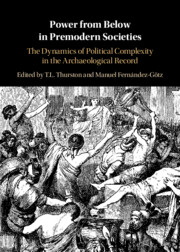 Power from Below in Premodern Societies
Power from Below in Premodern Societies Book contents
- Power from Below in Premodern Societies
- Power from Below in Premodern Societies
- Copyright page
- Contents
- Figures
- Contributors
- Preface
- One Power from Below in the Archaeological Record
- Two Fragmenting Trypillian Megasites
- Three Structure and Agency
- Four Power Requires Others
- Five “And Make Some Other Man Our King”
- Six Societies against the Chief? Re-Examining the Value of “Heterarchy” as a Concept for Studying European Iron Age Societies
- Seven Peasants, Agricultural Intensification, and Collective Action in Premodern States
- Eight The Spread of Scribal Literacy in Han China
- Nine Confronting Leviathan
- Ten The Emergence of Monte Albán
- Eleven Dispersing Power
- Twelve The Perplexing Heterarchical Complexity of New Guinea Fisher-Forager Polities at Contact
- Thirteen Restoring Disorder
- Index
- References
Eight - The Spread of Scribal Literacy in Han China
All along the Watchtowers
Published online by Cambridge University Press: 08 October 2021
- Power from Below in Premodern Societies
- Power from Below in Premodern Societies
- Copyright page
- Contents
- Figures
- Contributors
- Preface
- One Power from Below in the Archaeological Record
- Two Fragmenting Trypillian Megasites
- Three Structure and Agency
- Four Power Requires Others
- Five “And Make Some Other Man Our King”
- Six Societies against the Chief? Re-Examining the Value of “Heterarchy” as a Concept for Studying European Iron Age Societies
- Seven Peasants, Agricultural Intensification, and Collective Action in Premodern States
- Eight The Spread of Scribal Literacy in Han China
- Nine Confronting Leviathan
- Ten The Emergence of Monte Albán
- Eleven Dispersing Power
- Twelve The Perplexing Heterarchical Complexity of New Guinea Fisher-Forager Polities at Contact
- Thirteen Restoring Disorder
- Index
- References
Summary
Literacy and the exercise of power are intimately entangled. Claude Lévi-Strauss once famously argued that, by enabling “the integration of large numbers of individuals into a political system, and their grading into castes or classes … the primary function of written communication is to facilitate slavery” (Lévi-Strauss, 1973: 299). An analogous hegemony is propagated in academic discourses that rely upon the textual products of past elites. This is especially pertinent to the study of early China, which until recently “has concentrated, expressly or not, on the relationship between exceptional individuals, elite classes, power holders, and the written word” (Sanft, 2019: 2), influenced largely by the received canon of classics, histories, and masters literature. It would be presumptuous, however, to deny non-elite agency in the power dynamics contested through literacy; and it is therefore equally imperative that our scholarship reaches beyond elite texts to accommodate non-elite actors. To these ends, this chapter examines the impact of non-elite access to scribal literacy in early China, through the analysis of an archaeological context in which manuscript fragments of a scribal primer were recovered.
- Type
- Chapter
- Information
- Power from Below in Premodern SocietiesThe Dynamics of Political Complexity in the Archaeological Record, pp. 175 - 201Publisher: Cambridge University PressPrint publication year: 2021
